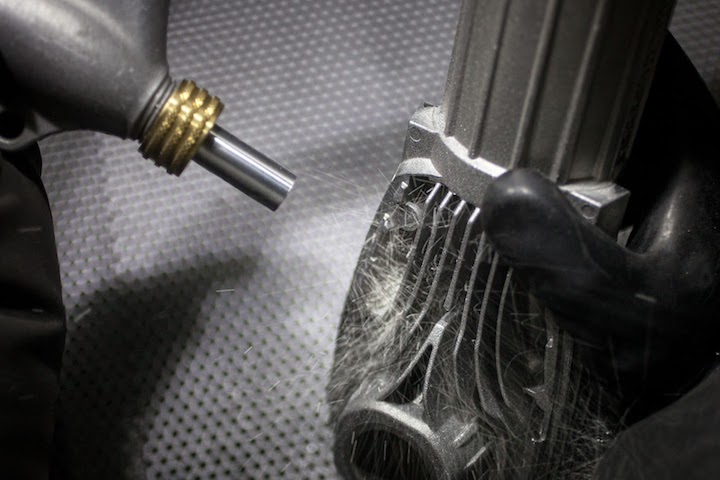Bead Blasting – An economical and effective surface finishing technique
Surface finishing is a crucial final step in CNC machining, essential for producing both functional and visually appealing parts. By applying a finish, you can enhance the appearance of CNC machined surfaces, eliminate defects and excess materials, and add extra durability or strength.
CNC machined parts offer various surface finish options, including as-machined, anodized, and powder coated. This article focuses on bead blasting, an economical and effective surface finishing technique.
What is Bead Blasting?
Bead blasting is a technique involving high-pressure propulsion of blasting media – specifically beads – to achieve cleaning, polishing, or texturing of a surface according to the required finish. This method employs a bead blaster, which forcefully ejects beads at the target surface. The collision of these beads with the surface results in a uniformly “dimpled” appearance. The process is capable of removing corrosion from metal, eradicating surface blemishes such as textures and impurities, and preparing an item for subsequent treatments like painting or coating.
The choice of beads, such as steel or glass, influences the type of finish achieved. Steel beads, known for their durability, are typically used to purge hard metal surfaces of contaminants and unwanted textures. On the other hand, glass or quartz sand beads offer a softer alternative, making them the preferred option for bead blasting. This preference is attributed to the smoother, more even finish provided by glass beads compared to steel. Furthermore, the outcome of glass bead blasting can vary depending on the bead size; finer beads produce a satin-like finish that strikes a balance between matte and glossy, whereas coarser beads create a consistently rough surface that conceals flaws.
When is Bead Blasting Used?
Bead blasting finds utility in swiftly eliminating coatings or corrosion, rectifying cosmetic defects, prepping surfaces for coatings, deburring surfaces, refining machined surface finishes, and enhancing surface uniformity for both cosmetic and mechanical purposes. For instance, machining marks from an end-mill may result in unsightly swirl tool marks with scratches and nicks. Bead blasting the surface can yield a satin-like finish that conceals imperfections, delivering a polished and professional aesthetic appearance.
What Media is Used in Bead Blasting?
Bead blasting employs various types of media to achieve specific objectives. Below are the primary categories of media along with different variations tailored to meet your desired outcomes.
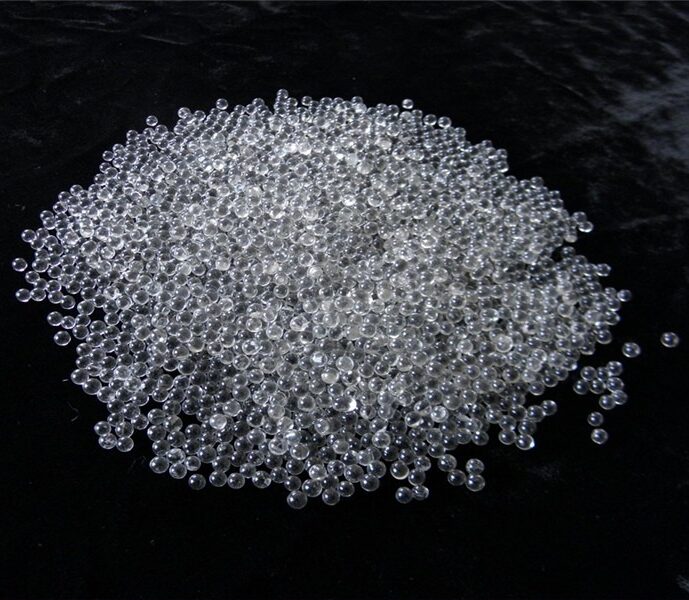
Glass Beads
Spherical beads crafted from lead-free soda-lime glass, glass beads enable non-aggressive cleaning and micro-peening for a luminous satin finish. Available in diverse grain sizes, glass beads adapt to the part’s initial condition and the required level of abrasiveness. They are easily reusable and recyclable.
Sand
Sandblasting commonly employs small aluminum oxide particles known for their sharp, angular edges, resulting in aggressive material removal. However, sandblasting can induce dimensional distortion and excessive material removal if not carefully controlled. Ideal for removing surface contaminants, corrosion, paint, and achieving uniform as-machined surfaces. Sand media is recyclable but may suffer from contamination due to its high material removal rate.
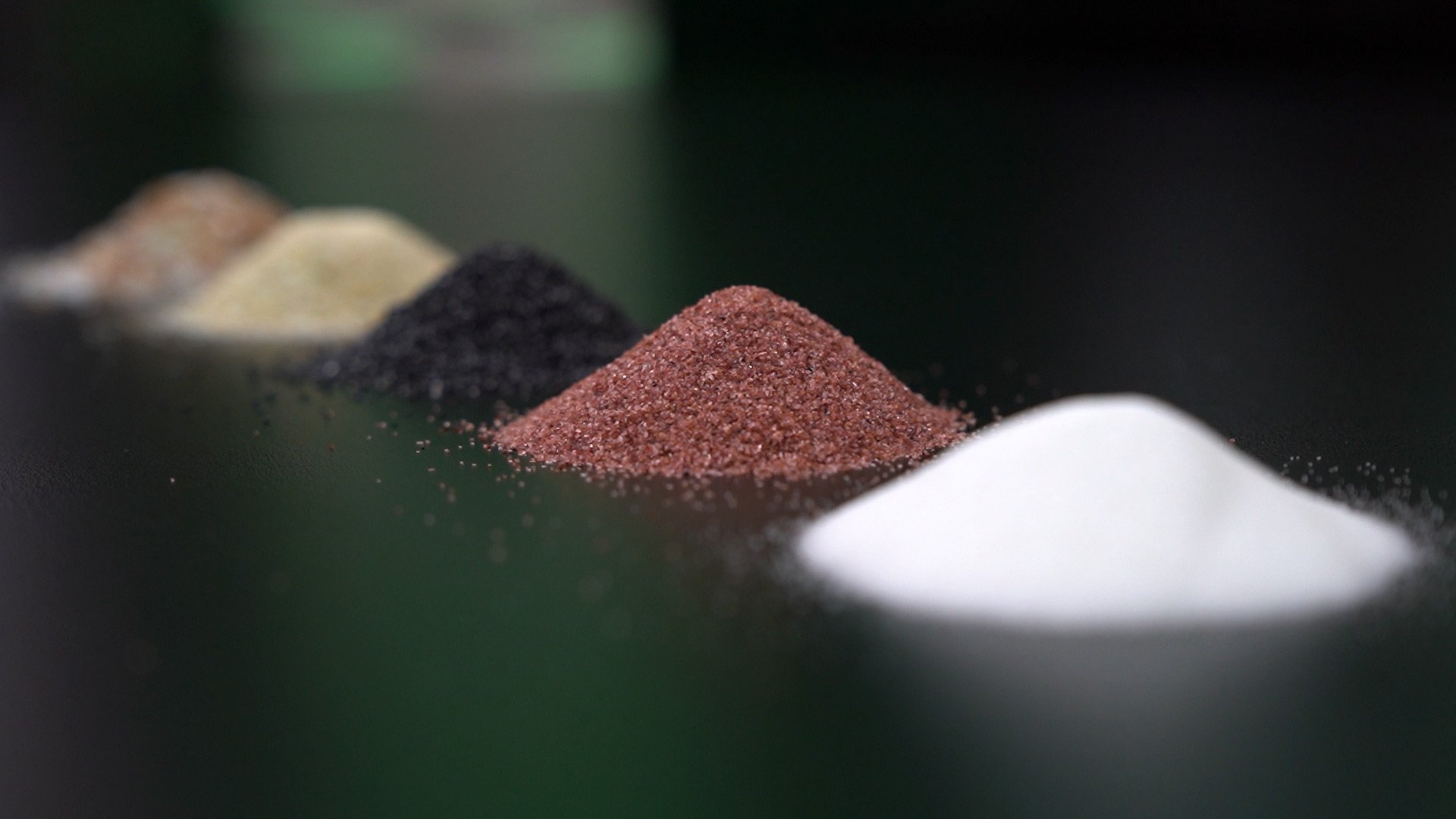

Shot
Typically stainless steel-made, shot media yields smoother, polished surfaces compared to glass or sand blasting. Available in various sizes to achieve finer or coarser finishes, steel shot also provides a substantial peening effect while generating less dust than other media types. It’s essential to ensure material compatibility with stainless steel media before use, as not all materials are suitable.
Plastic
Plastic abrasive blasting is a mild technique mainly employed for superficial removal or adjustments, particularly suitable for cleaning delicate objects without harming the base material. Crafted from crushed urea, polyester, or acrylic plastic, plastic abrasives are available in diverse hardness levels and particle sizes. This method yields minimal dust and is compatible with materials such as aluminum, brass, fiberglass, and plastics.

Distinguishing Between Bead Blasting and Sandblasting
The primary disparity between sandblasting and bead blasting lies in their abrasive media: sandblasting employs fine sand, while bead blasting utilizes small glass particles. Both methods effectively remove paint and other materials from various equipment.
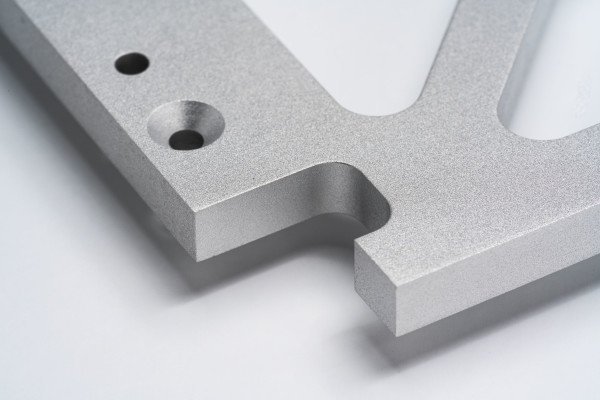
Sandblasting
Sandblasting utilizes a high-pressure tool, resulting in a quicker process compared to bead blasting. However, the abrasive nature of sandblasting can be harsher on metal surfaces, akin to using sandpaper. Besides its speed, sandblasting possesses greater power, allowing for smoothing and shaping of the underlying material.
Bead Blasting
Bead blasting shares similarities with sandblasting but operates at lower air pressure, making it a slower and more delicate process. It is particularly suitable for cleaning metal surfaces without causing damage. Bead blasting yields a more polished finish compared to sandblasting.

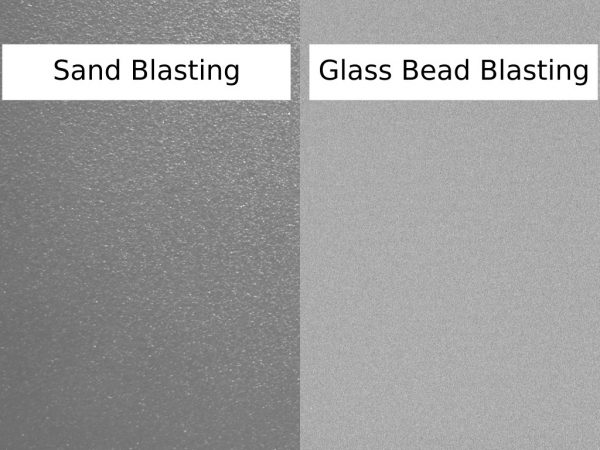
Safety Considerations
Custom Can’t find the finish you require? Submit an RFQ, and we’ll explore a finishing process tailored to your needs.
Functions of Bead Blasting Finishes
Bead blasting is a versatile finishing process used across various industries. The principal functions include:
Peening: This process relieves stress in metal components.
Deburring: It removes sharp edges from machined parts.
Cleaning: Bead blasting is employed to eliminate contaminants like rust, paint, and oil from surfaces.
Finishing: It produces a matte finish on surfaces.
Polishing: This application enhances the shine on metal surfaces.
Advantages and Disadvantages of Bead Blasting
Advantages
1. Bead blasting offers a cost-effective and relatively gentle surface finishing solution.
2. It maintains the original color of components, resulting in a brighter finish.
3. Bead media can be reused multiple times, and glass beads are recyclable up to 30 times.
4. It is environmentally friendly, especially when using lead-free soda-lime glass beads that don’t leave harmful residues in water sources.
5. Selective masking of surfaces during bead blasting is possible but adds to labor and cost.
Despite these benefits, there are drawbacks to glass bead blasting:
1. It is a subtractive process, removing a small amount of material, which may not be suitable for components with strict tolerances.
2. Bead blasting takes longer on tougher surfaces.
3. Unlike steel blasting, glass bead blasting does not create a surface profile conducive to paint adherence.
4. Skilled operators are required for effective bead blasting, as the quality of the finish depends largely on their expertise.
Other Finishing Services Available
Our One-Stop Finishing Excellence
Benefit from Fuyu’s industry-leading expertise, offering unparalleled quality and convenience through our comprehensive, one-stop finishing services.
Anodizing type II (Glossy)
Anodizing type II (Matte)
Anodizing Type III Hard anodizing
LEARN MORE
Zinc Plating
Chrome Plating
Nickel Plating
Copper Plating
Electroless Nickel Plating
Tin Plating
Gold Plating
Silver Plating
LEARN MORE
Mechanical Polishing
Chemical Polishing
Electrolytic Polishing
LEARN MORE
Glass Bead Blasting
Ceramic Bead Blasting
Plastic Bead Blasting
Steel Shot Blasting
Stainless Steel Bead Blasting
LEARN MORE
Powder coating, a dry finishing process, involves the electrostatic charging and spraying of finely ground particles of pigment and resin onto surfaces. Upon curing under heat, this method produces a resilient, uniform, and aesthetically pleasing finish, gaining popularity for its environmental friendliness and superior performance benefits.
LEARN MORE
Black oxide, a conversion coating in the realm of surface finishing, chemically engenders a protective black layer on metals, predominantly focusing on ferrous alloys. This process not only boosts corrosion resistance but also diminishes light reflection, adding a touch of decorative appeal. Administered through either hot or cold processes, the finish is frequently sealed with wax or oil, elevating both durability and protection.
LEARN MORE
Chromate conversion coating, also recognized as Alodine or Chemfilm, serves as a surface treatment tailored for aluminum and its alloys. This process establishes a thin yet protective chromate layer, elevating corrosion resistance, fostering paint adhesion, and ensuring electrical conductivity. Widely employed in aerospace and automotive industries, it not only provides enhanced functionality but also delivers a decorative finish while maintaining minimal dimensional alterations.
DLC (Diamond-Like Carbon) coating stands as a nanocomposite finish designed to provide materials with a robust and wear-resistant surface. Emulating the properties of natural diamond, it delivers exceptional lubricity, corrosion resistance, and a minimized friction coefficient. This makes DLC coating particularly well-suited for applications in the automotive industry, tools, and precision components.
In the realm of surface finishing, brushing employs abrasive brushes to craft fine and uniform lines on metal surfaces. This mechanical process not only elevates the appearance but also conceals defects and primes surfaces for coatings. With the capability to provide an array of textures, ranging from short to long grains, brushing ensures aesthetic refinement tailored for diverse applications.
Titanium anodizing is a surface finishing process designed to enhance the oxide layer on titanium components. This modification not only boosts corrosion resistance and biocompatibility but also introduces vibrant, interference-based colors without the need for dyes or pigments. Widely adopted in medical devices and aerospace applications, this process seamlessly combines aesthetics with functional advantages.
Passivation is a surface finishing process that treats stainless steel with a mild oxidant, removing iron contaminants and enhancing its natural oxide layer. This strengthens corrosion resistance and prevents unwanted reactions in environments like the medical, food, and aerospace industries.
FAQs – About Bead Blasting
Is bead blasting safe?
Yes, bead blasting is safe because it is performed within an enclosed cabinet, preventing exposure to fumes or dust. Additionally, protective gloves safeguard your hands. Always observe necessary safety precautions as with any high-pressure equipment.
How long does bead blasting take?
The duration required for bead blasting depends on the size of the area and the desired finish. A smaller area might take only a few minutes, whereas a larger area could require several hours.
Can you bead blast aluminum?
Yes, aluminum surfaces can be bead blasted. Typically, aluminum parts needing a matte finish undergo bead blasting.
Is it better to bead blast or sandblast?
Each method has its benefits. Sandblasting is more aggressive, making it suitable for removing paint or rust. Bead blasting, being a gentler technique, is preferable for more delicate workpieces.

